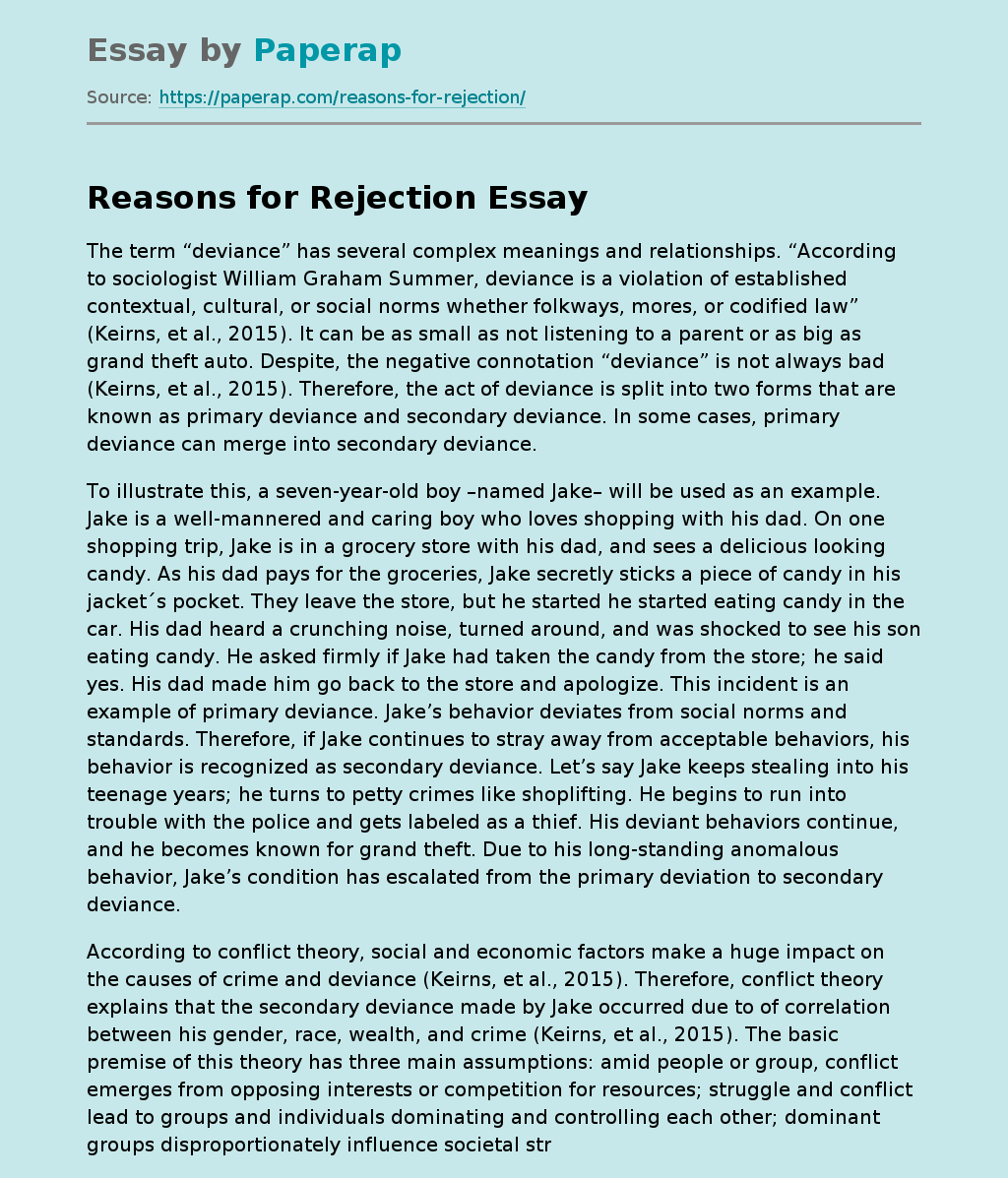Reasons for Rejection
The term “deviance” has several complex meanings and relationships. “According to sociologist William Graham Summer, deviance is a violation of established contextual, cultural, or social norms whether folkways, mores, or codified law” (Keirns, et al., 2015). It can be as small as not listening to a parent or as big as grand theft auto. Despite, the negative connotation “deviance” is not always bad (Keirns, et al., 2015). Therefore, the act of deviance is split into two forms that are known as primary deviance and secondary deviance.
In some cases, primary deviance can merge into secondary deviance.
To illustrate this, a seven-year-old boy –named Jake– will be used as an example. Jake is a well-mannered and caring boy who loves shopping with his dad. On one shopping trip, Jake is in a grocery store with his dad, and sees a delicious looking candy. As his dad pays for the groceries, Jake secretly sticks a piece of candy in his jacket´s pocket. They leave the store, but he started he started eating candy in the car.
His dad heard a crunching noise, turned around, and was shocked to see his son eating candy. He asked firmly if Jake had taken the candy from the store; he said yes. His dad made him go back to the store and apologize. This incident is an example of primary deviance. Jake’s behavior deviates from social norms and standards. Therefore, if Jake continues to stray away from acceptable behaviors, his behavior is recognized as secondary deviance. Let’s say Jake keeps stealing into his teenage years; he turns to petty crimes like shoplifting.
He begins to run into trouble with the police and gets labeled as a thief. His deviant behaviors continue, and he becomes known for grand theft. Due to his long-standing anomalous behavior, Jake’s condition has escalated from the primary deviation to secondary deviance.
According to conflict theory, social and economic factors make a huge impact on the causes of crime and deviance (Keirns, et al., 2015). Therefore, conflict theory explains that the secondary deviance made by Jake occurred due to of correlation between his gender, race, wealth, and crime (Keirns, et al., 2015). The basic premise of this theory has three main assumptions: amid people or group, conflict emerges from opposing interests or competition for resources; struggle and conflict lead to groups and individuals dominating and controlling each other; dominant groups disproportionately influence societal structures. These factors impact Jake because the inequalities divide and set limits on the life opportunities of people that are in the lower-class. This effects Jake’s ability discovered and utilized their talents. Further, this waste of productivity and inequality can cause Jake’s chances of being convicted as a criminal to upsurge.
As understood by Sociologist Robert Merton, “deviance is an inherent part of a functioning society” (Keirns, et al., 2015). Thus, with the strain theory he explains “that access to socially acceptable goals plays a part in determining whether a person conforms or deviates” (Keirns, et al., 2015). As well, it demonstrates how the secondary deviance committed by Jake occurred. The basic premise of this theory has five types of responses: ‘conformity: people that do not deviate and chase goals, which are can pass through socially accepted means; invitation: people that chase goals they cannot achieve through legitimate means by using criminal or deviant means instead; ritualism: people who lower their goals until they can achieve them through socially acceptable ways, also they focus on conformity rather than achieving a distant dream; retreatism: people that retreat and reject society’s goals and means; rebellion: people that replace societies goals and means with their own’ (Keirns, et al., 2015). These factors impact Jake’s chances of becoming deviant because he does have the same amenities or opportunities as other people, particularly the upper-class. In the same breath, this is the theory’s biggest weakness; it does not include any problems faced by the upper, rather it solely focuses on the middle and lower class.
Nonetheless, deviance can be displayed by any person. It occurs from inequalities in social, political, or material circumstances. This is due to violations of social norms. Furthermore, it shows how deviance is a behavior, condition, or belief that infringes upon cultural or societal understandings.
Reasons for Rejection. (2021, Dec 10). Retrieved from https://paperap.com/reasons-for-rejection/

